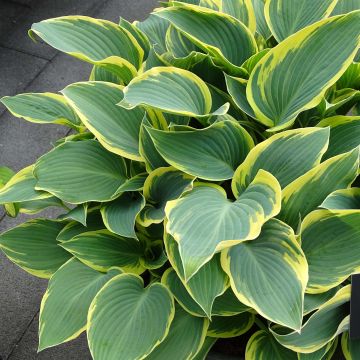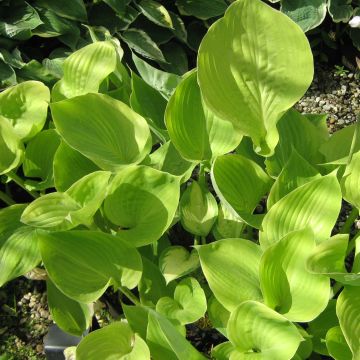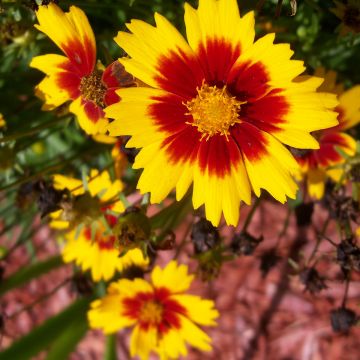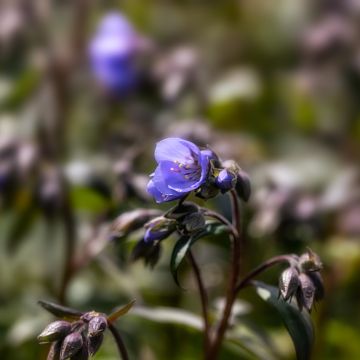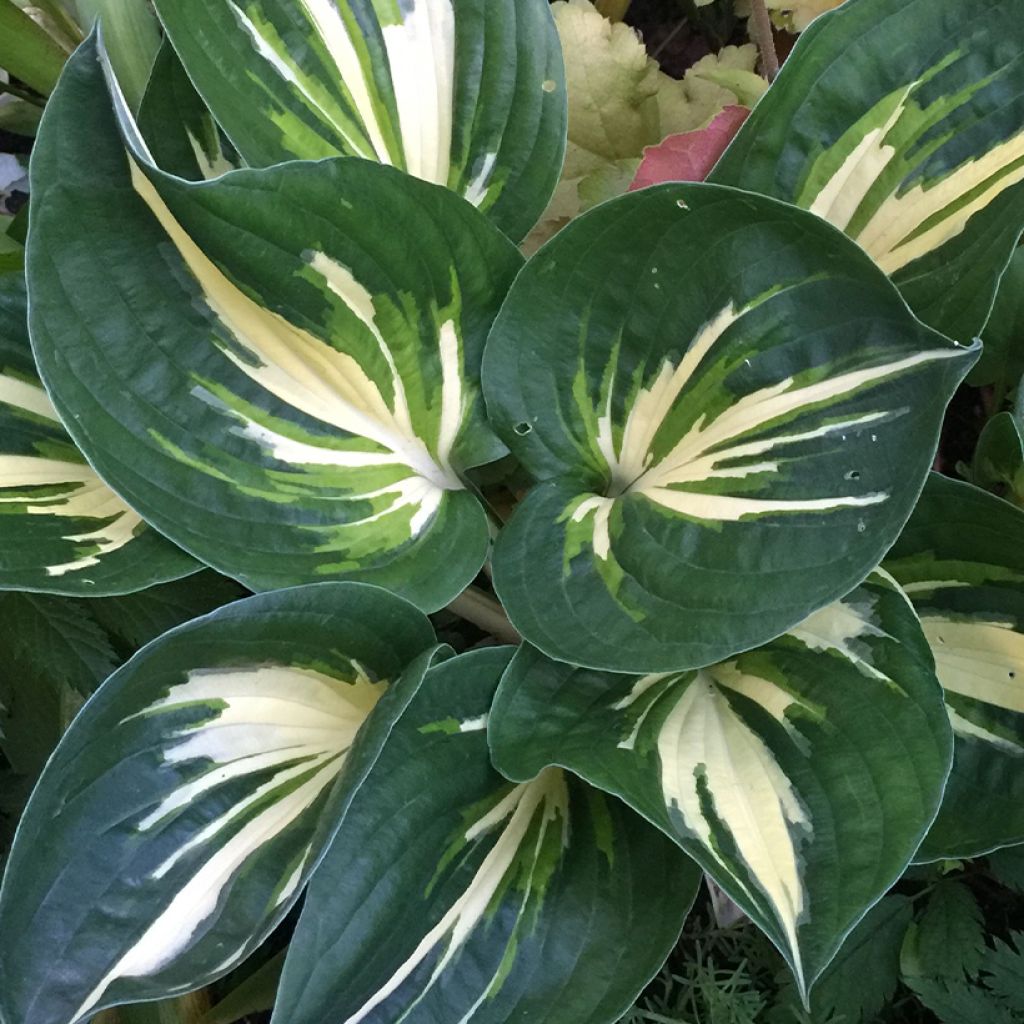

Hosta Clifford's Stingray


Hosta Clifford's Stingray


Hosta Clifford's Stingray
Hosta Cliffords Stingray
Hosta Clifford's Stingray
Plantain Lily, Funkia
This item cannot be shipped to the selected country
Delivery charge from €5.90
More information
Schedule delivery date,
and select date in basket
This plant carries a 12 months recovery warranty
More information
We guarantee the quality of our plants for a full growing cycle, and will replace at our expense any plant that fails to recover under normal climatic and planting conditions.
From €5.90 for pickup delivery and €6.90 for home delivery
Express home delivery from €8.90.
Does this plant fit my garden?
Set up your Plantfit profile →
Description
The Hosta 'Clifford's Stingray' is an elegant, low variety whose leaves are adorned with a narrow cream-white centre, bordered by a wide, irregular, dark green margin, with a touch of celadon green linking these two colors. They are oval and cordate in shape, thick, veined, slightly curled. It is a hosta for partial shade that forms a compact clump. Its late summer flowering is in spikes adorned with mauve bells. It makes a big impact in the garden where its moderate proportions and brightness are perfect for graphic borders, flower beds, or pots. Hostas like cool, well-drained, ordinary to rich soil.
This Hosta, or Funkia 'Clifford's Stingray', is a completely hardy perennial that belongs to the asparagaceae family. This variety comes from the Hosta 'Loyalist'. It was obtained by John Clifford in 2000. It is a deciduous perennial that is very hardy, and only produces its leafy clump from spring onwards. It forms a compact clump. The mature plant, which takes 5 years to reach its full size, measures 40 cm (16in) in all directions. Its leaves are oval and pointed, veined and slightly twisted, about 15 cm (6in) tall and 10 cm (4in) wide. They have a variegated pattern of cream-white and dark green, forming a beautiful design. Flowering takes place in August and September, in the form of elongated lavender-coloured bells. This perennial spreads through stolons, similar to strawberries. It is a long-lived plant.
Hostas are sensitive to drought and hot exposures. A location exposed to afternoon sun should be avoided as it can burn the leaves of these perennials. With their generous and decorative foliage, they are perfect as ground cover, borders, or in semi-shady to shady flower beds, where other plants struggle to grow. Indeed, they prefer sheltered and cool locations such as woodlands. In general, exposure to morning sun allows optimal development of these perennials and also makes them more floriferous. At the edge of woodlands, sheltered from the wind, where the soil is deep and fertile, this Hosta Clifford's Stingray pairs well with ferns, meadow rues, and Claytonia sibirica, forming beautiful colourful duos that require little maintenance. It will also look great alongside columbines, Brunneras, and Heucheras in borders. All hostas grow well in pots and can remain in the same container for several years.
Most species commonly found in Western gardens have been introduced from Japan. Hostas are edible and are called 'urui' in Japan, where they are commonly consumed.
Report an error about the product description
Flowering
Foliage
Plant habit
Botanical data
Hosta
Clifford's Stingray
Liliaceae - Hostaceae
Plantain Lily, Funkia
Cultivar or hybrid
Other Hostas A to Z
Planting and care
Hostas are planted in spring or autumn. Hostas prefer a deep, humus-rich, loose soil, preferably neutral to acidic (at least low in limestone), moist to wet throughout the year. Plant them in partial shade or dappled shade and in a sheltered location away from strong winds.
Prepare a planting hole of 20 cm (8in) x 20 cm (8in) x 20 cm (8in). If your soil is heavy, mix half compost with crumbled soil, partially backfill the hole, and place your plant so that the top of the root ball is covered with 3 cm (1in) of soil. Adding a slow-release fertiliser (dehydrated blood, horn powder) will nourish your plant during its rooting period without the risk of burning. Make sure to position the collar well above ground level. Firm the soil and water thoroughly to eliminate air pockets. If the weather is dry, you will need to water regularly for a few weeks to facilitate the establishment of your plant. Also, water regularly in case of dry summer.
With their common preference for moist locations, slugs and snails never stray far from hostas. Even though blue or variegated hostas often have thicker and tougher foliage, which is less appetising to slugs, these plants need to be protected from gastropods. Protect your hosta plants by surrounding them with ferramol-based pellets (approved for Organic Agriculture), eggshells, coffee grounds, mulch, or any dry and rough natural substance that repels them. Hedgehogs are the gardener's best allies in controlling gastropods, as unlike chickens, they do not dig up soil and do not attack the fresh green shoots of young plants. Finally, some plants have a repellent scent for slugs, such as wormwood and garlic.
Planting period
Intended location
Care
This item has not been reviewed yet - be the first to leave a review about it.
Summer flowering perennials
Haven't found what you were looking for?
Hardiness is the lowest winter temperature a plant can endure without suffering serious damage or even dying. However, hardiness is affected by location (a sheltered area, such as a patio), protection (winter cover) and soil type (hardiness is improved by well-drained soil).

Photo Sharing Terms & Conditions
In order to encourage gardeners to interact and share their experiences, Promesse de fleurs offers various media enabling content to be uploaded onto its Site - in particular via the ‘Photo sharing’ module.
The User agrees to refrain from:
- Posting any content that is illegal, prejudicial, insulting, racist, inciteful to hatred, revisionist, contrary to public decency, that infringes on privacy or on the privacy rights of third parties, in particular the publicity rights of persons and goods, intellectual property rights, or the right to privacy.
- Submitting content on behalf of a third party;
- Impersonate the identity of a third party and/or publish any personal information about a third party;
In general, the User undertakes to refrain from any unethical behaviour.
All Content (in particular text, comments, files, images, photos, videos, creative works, etc.), which may be subject to property or intellectual property rights, image or other private rights, shall remain the property of the User, subject to the limited rights granted by the terms of the licence granted by Promesse de fleurs as stated below. Users are at liberty to publish or not to publish such Content on the Site, notably via the ‘Photo Sharing’ facility, and accept that this Content shall be made public and freely accessible, notably on the Internet.
Users further acknowledge, undertake to have ,and guarantee that they hold all necessary rights and permissions to publish such material on the Site, in particular with regard to the legislation in force pertaining to any privacy, property, intellectual property, image, or contractual rights, or rights of any other nature. By publishing such Content on the Site, Users acknowledge accepting full liability as publishers of the Content within the meaning of the law, and grant Promesse de fleurs, free of charge, an inclusive, worldwide licence for the said Content for the entire duration of its publication, including all reproduction, representation, up/downloading, displaying, performing, transmission, and storage rights.
Users also grant permission for their name to be linked to the Content and accept that this link may not always be made available.
By engaging in posting material, Users consent to their Content becoming automatically accessible on the Internet, in particular on other sites and/or blogs and/or web pages of the Promesse de fleurs site, including in particular social pages and the Promesse de fleurs catalogue.
Users may secure the removal of entrusted content free of charge by issuing a simple request via our contact form.
The flowering period indicated on our website applies to countries and regions located in USDA zone 8 (France, the United Kingdom, Ireland, the Netherlands, etc.)
It will vary according to where you live:
- In zones 9 to 10 (Italy, Spain, Greece, etc.), flowering will occur about 2 to 4 weeks earlier.
- In zones 6 to 7 (Germany, Poland, Slovenia, and lower mountainous regions), flowering will be delayed by 2 to 3 weeks.
- In zone 5 (Central Europe, Scandinavia), blooming will be delayed by 3 to 5 weeks.
In temperate climates, pruning of spring-flowering shrubs (forsythia, spireas, etc.) should be done just after flowering.
Pruning of summer-flowering shrubs (Indian Lilac, Perovskia, etc.) can be done in winter or spring.
In cold regions as well as with frost-sensitive plants, avoid pruning too early when severe frosts may still occur.
The planting period indicated on our website applies to countries and regions located in USDA zone 8 (France, United Kingdom, Ireland, Netherlands).
It will vary according to where you live:
- In Mediterranean zones (Marseille, Madrid, Milan, etc.), autumn and winter are the best planting periods.
- In continental zones (Strasbourg, Munich, Vienna, etc.), delay planting by 2 to 3 weeks in spring and bring it forward by 2 to 4 weeks in autumn.
- In mountainous regions (the Alps, Pyrenees, Carpathians, etc.), it is best to plant in late spring (May-June) or late summer (August-September).
The harvesting period indicated on our website applies to countries and regions in USDA zone 8 (France, England, Ireland, the Netherlands).
In colder areas (Scandinavia, Poland, Austria...) fruit and vegetable harvests are likely to be delayed by 3-4 weeks.
In warmer areas (Italy, Spain, Greece, etc.), harvesting will probably take place earlier, depending on weather conditions.
The sowing periods indicated on our website apply to countries and regions within USDA Zone 8 (France, UK, Ireland, Netherlands).
In colder areas (Scandinavia, Poland, Austria...), delay any outdoor sowing by 3-4 weeks, or sow under glass.
In warmer climes (Italy, Spain, Greece, etc.), bring outdoor sowing forward by a few weeks.







































